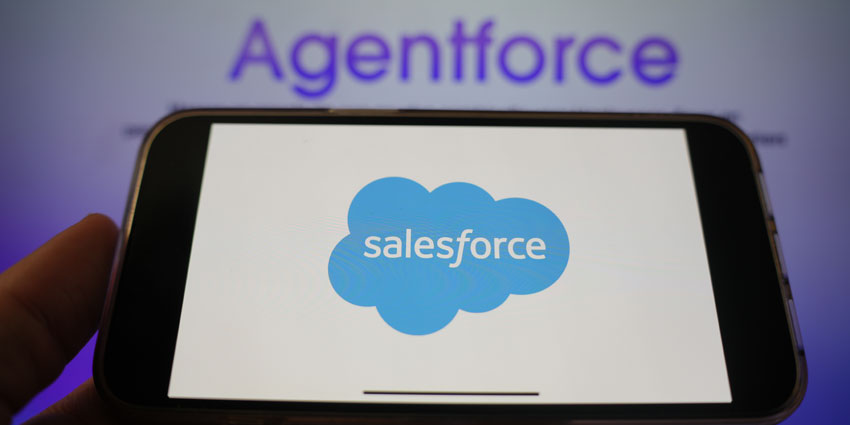Salesforce launched two industry-specific Agentforce offerings in three days last week.
First came Agentforce for Public Sector, swiftly followed by Agentforce for Manufacturing.
The offerings target the respective sectors with a library of prebuilt skills and actions to more quickly configure AI agents.
Both announcements are an extension of Salesforce’s industry-specific strategy, with the CRM leader previously releasing similar solutions for consumer goods, education, financial services, healthcare, and retail.
Salesforce has also developed department-specific Agentforce offerings, covering commerce, field service, sales, service, and – more recently – HR.
The strategies seemingly have the same objective: to get businesses experimenting with Agentforce, securing quick wins, and instilling confidence in AI agents.
In doing so, Salesforce hopes to inspire broader adoption and build an appetite for more mature AI agent approaches.
Such approaches may include chaining AI agents together to mechanize multi-step processes.
Kishan Chetan, EVP and GM for Service Cloud, shared more on the strategy during a press briefing before the launch of Agentforce for HR.
“The reason we created these specialized solutions is to ensure the topics and actions are relevant to each specific workflow,” he said.
“For example… in health and life sciences, it’s about tasks like logging health information, interacting with payers, or requesting provider appointments.
Essentially, the goal is to provide the right actions for each function, while keeping everything on one unified platform.
“If customers want to combine these capabilities and create agents with multiple skills, they absolutely can,” concluded Chetan. “That flexibility is a major advantage.”
Lastly, as vendors make AI agent announcements much faster than most enterprises can execute, these Agentforce offerings can help them catch up.
In this sense, Salesforce is challenging innovation fatigue, which is particularly prevalent amongst its customer base, having released Agentforce 3 little more than nine months after the original platform’s debut.
What Can I Build with Agentforce for Manufacturing?
With Agentforce for Manufacturing, businesses can build AI agents that assist with tasks such as monitoring demand fluctuations, streamlining inventory, and optimizing incentives.
As Achyut Jajoo, SVP and GM of Manufacturing for Automotive and Consumer Goods at Salesforce, explained:
We’re delivering that with out-of-the-box agents that understand their (manufacturers) specific challenges, from preventing asset downtime to aligning sales plans and operations, and immediately work alongside their teams to drive results.
Here are four examples of what manufacturing companies can now more easily build on Agentforce.
1. A Production and Sales Alignment Agent
With a new “Sales Agreement Management” skill, manufacturers can implement an AI agent that monitors build plans and flags significant deviations between planned and actual product sales.
When such deviations occur, the agent can schedule a meeting with key stakeholders, sharing suggested talking points with the account team.
In doing so, the AI agent helps optimize production alignment and resource allocation.
2. An Inventory Checker
Agentforce for Manufacturing enables the development of an AI agent that sales and service teams can use to instantly check inventory during customer conversations.
If necessary, the sales and service team can also request stock replenishment via the agent.
Lastly, the agent may also suggest upsell and cross-sell opportunities in real time, helping boost sales and manage inventory more efficiently.
3. An Incentive Program Analyzer
Manufacturers can also build an AI agent that assists product teams and rebate program managers in tracking incentive programs.
In doing so, the agent surfaces insight into insights into performance, payouts, and profitability.
Additionally, it can aid channel sales teams in spotting underperforming programs, so they can instead focus on those that drive real profits.
4. An Asset Health Monitor
With the “Prevent Asset Downtime with AI” skill, businesses can build an agent that does exactly what it says on the tin: prevent asset downtime.
Indeed, the agent helps service reps and fleet managers by detecting potential asset issues early and automating tasks like generating repair quotes, creating work orders, and sending maintenance summaries.
Alongside that, the agent may also proactively warn customers of problems, reducing downtime and protecting revenue.
What Can I Build with Agentforce for the Public Sector?
With Agentforce for Public Sector, businesses can build AI agents that engage with constituents and employees, accelerate recruitment, simplify complaint management, and more.
Celebrating its launch, Nasi Jazayeri, EVP & GM of Public Sector at Salesforce, said:
With AI agents working alongside dedicated government workers and providing 24/7 support for constituents, helping with everything from routine inquiries to complex, time-consuming tasks, Agentforce will power a more responsive, agile, and effective government.
Here are some examples of the AI agents governments may now develop.
1. An Inspection Support Agent
The new Agentforce offering allows brands to build an AI agent that provides detailed summaries of prior violations and license compliance, helping inspectors conduct more efficient inspections.
Moreover, it could automate documentation and other follow-up tasks, reducing administrative load and supporting overall regulatory compliance.
2. A Complaint Analyzer
One possible agent could help agencies by summarizing and analyzing constituent complaints. It might then identify related past issues and suggest next steps based on policies and regulations.
The agent may also categorize the complaints, flagging frequent and emerging issues so that the agency can improve its services and policies.
3. A Recruitment Specialist
Consider an AI agent that matches resumes, engages candidates, and automates communications.
Agentforce for Public Sector could enable such an agent. It may also assess qualifications, filter candidates for hiring managers, and accelerate the recruitment cycle.
4. A Candidate Assistant
Government agencies may now more quickly build an AI agent that helps improve the candidate experience by matching their CV with best-fit postings.
Indeed, it can gauge their job history, skills, and goals to pair them with relevant postings, so they save time scouring jobs and increase application success rates.
5. A Benefit Advisor
Another possible AI agent could take questions from constituents regards their benefits and eligibility across numerous languages.
From there, it may provide assistance while accelerating their application processing, minimizing process errors, and enhancing policy compliance.
6. A Compliance Supervisor
One final example is an AI agent that works with employees and complainants, helping them spot compliance information and navigate through filing complaints.
In doing so, the AI supervisor ensures the user adheres to regulations, accelerating reviews and chopping down resolution times.
More Changes to Agentforce
Alongside its industry-specific Agentforce offerings, Salesforce is making other moves to drive adoption of its AI agent platform.
For instance, last week, it announced two big changes to the Agentforce pricing model. These introduced pay-as-you-go and pre-commit pricing options.
The former is ideal for those wishing to experiment and ramp. Meanwhile, for those ready to go all-in, the latter is perhaps the better option.
Either way, Salesforce is covering all the bases.
Meanwhile, the CRM leader expanded its Agentforce platform in June to include a Command Center. The solution offers a platform to monitor enterprise-wide AI agent deployments, tracking their adoption, relevant success indicators, and costs.
Salesforce is far from the first vendor to launch such a solution. However, Tableau’s business intelligence heritage and agentic analytics vision give it a differentiator here.
Expect more announcements on Tableau, Agentforce, and Salesforce’s broader ecosystem at September’s Dreamforce conference.
At a time of so much disruption, it promises to be a don’t-miss event.







